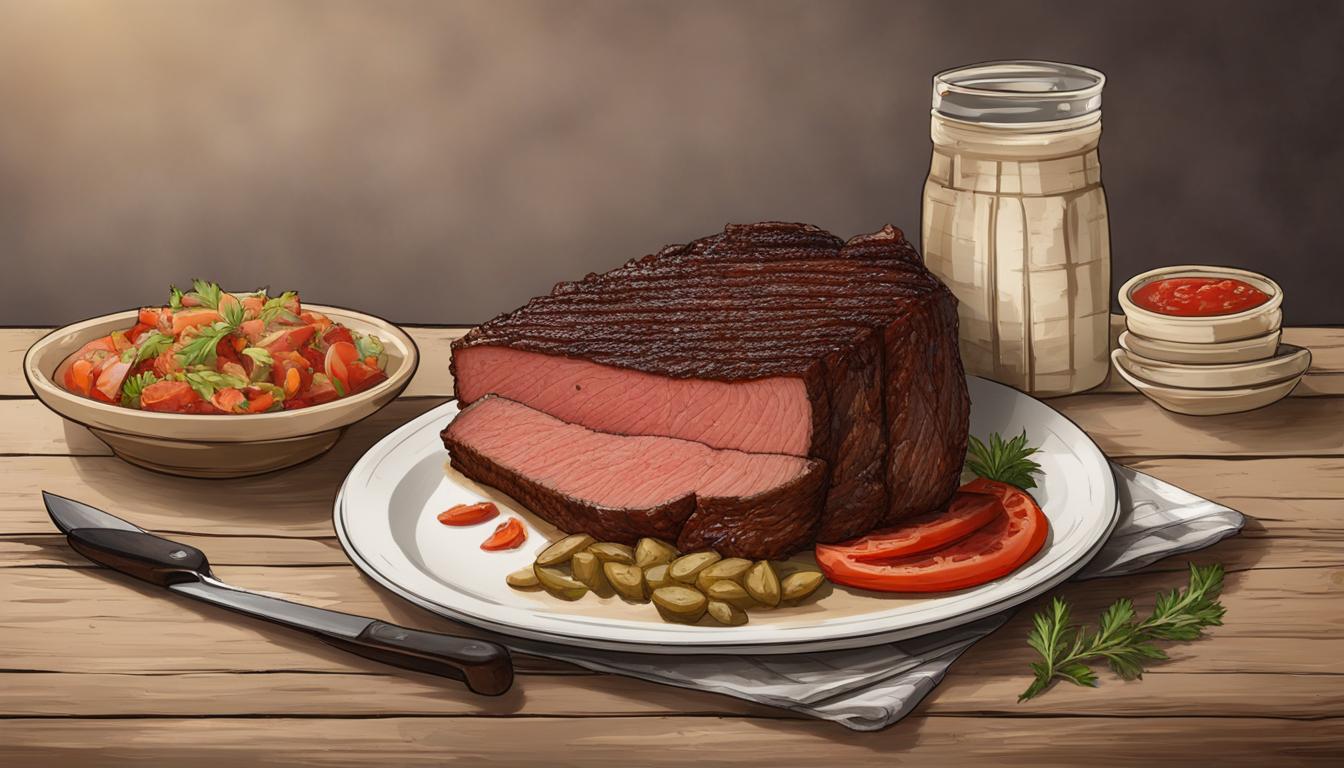As someone deeply involved in event planning, I understand the fine line between abundance and excess when it comes to catering. Mastering the portion size of meats, particularly brisket, is a craft in itself. When wondering ‘How Much Brisket Per Person Do I Need,’ it is critical to recognize that each guest typically savors half a pound of this succulent meat when cooked.
Given that brisket undergoes significant shrinkage—up to 50% weight loss from cooking, along with about 10% further depletion from trimming—it’s essential to calculate with precision. For instance, a 15-pound uncooked packer brisket can satiate approximately 15 guests. To assist you in this, a brisket portion calculator becomes an invaluable asset, reliably guiding your purchasing decisions tailored to your event’s size.
Whether you are a seasoned caterer or a novice cooking for a large family gathering, the question of ‘How Much Brisket Per Person Do I Need’ can be daunting. My goal in this guide is to simplify the calculations, offer brisket serving recommendations, and share a custom brisket portion calculator tool that will provide clarity and certainty to your event planning.
Key Takeaways
- Account for a 50% reduction in weight due to brisket’s cooking process, plus a 10% loss from trimming.
- A 15-pound raw packer brisket generally serves 15 people, aligning with the standard serving recommendation.
- The brisket portion calculator is a vital resource for accurate catering calculations.
- Brisket serving sizes should be based on cooked weight, not raw, for a true reflection of portion sizes.
- Event success hinges on precise portion estimates, preventing both food wastage and shortages.
Introduction to Brisket Planning for Your Event
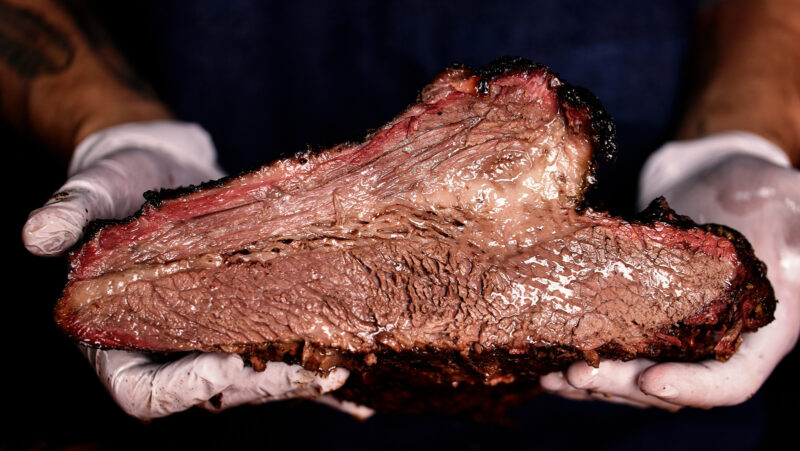
As an event planner and someone passionate about creating memorable dining experiences, I recognize the essential role brisket can play at a gathering. Determining the ideal brisket serving size is both an art and a science, significantly influencing party satisfaction and budget management. This introduction to brisket catering guide principles will equip you with the insights needed to make an educated choice on how much brisket to prepare and serve for your special event.
The fundamentals established here are designed to prepare you to effectively use our handy brisket calculator tool and deploy invaluable advice for your affair. Brisket party planning may seem overwhelming, but with the appropriate guidance, you can effortlessly navigate portion sizes relative to the number of guests and the interplay of brisket with other foods presented at your event.
Let’s delve into the factors that will influence your brisket planning:
- Understanding the cut: Knowing the specifics of brisket cuts, from a full packer to point and flat, will affect cooking times and yields.
- Cooking methods: Whether you smoke, braise, or grill your brisket will impact the weight loss percentage and tenderness—variables to consider when purchasing raw brisket.
- Additional edibles: Brisket may be the star, but it’s not a solo act. Your full menu—a symphony of appetizers, sides, and desserts—will guide portion decisions.
Below is a table that demonstrates cooked brisket yield based on uncooked weight, which is foundational to understanding portioning for your guests:
| Uncooked Brisket Weight (lbs.) | Expected Cooked Yield (lbs.) | Estimated Number of Guests Served* |
|---|---|---|
| 5 | 2.5 | 5 |
| 10 | 5 | 10 |
| 15 | 7.5 | 15 |
| 20 | 10 | 20 |
*Assuming 1/2 lb serving size per guest with 50% weight loss after cooking.
Remember, the secret to a successful event lies in details such as these, where forethought and precision in planning promise an ample, satisfying feast with minimal waste. The right brisket serving size will garner praise and pleasure, leaving guests reminiscing about your event’s culinary highlights well after the last plate is cleared.
The Importance of Accurate Brisket Portioning
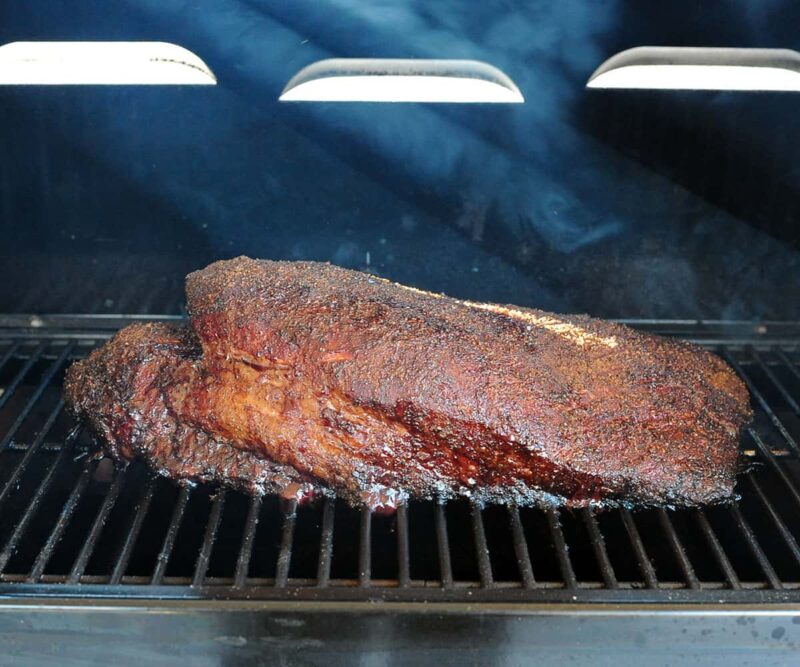
When it comes to delivering a satisfying meal at any sizeable gathering, mastering the quantity of brisket per person is essential. As someone deeply immersed in the nuances of catering satisfaction and the art of hosting, I resonate with the pressure of ensuring that each plate is both fulfilling and economically considered. The focus here is on understanding the intricacies of brisket weight loss during cooking and leveraging tools like an efficient brisket portion calculator for flawless execution.
Understanding Brisket Weight Loss During Cooking
In my experience, one of the most significant miscalculations can arise from underestimating the impact of cooking on brisket weight. The mantra for novices and experts alike should be to remember that brisket typically loses between 40%-50% of its weight through the cooking process. A succulent brisket starts large and imposing raw but will render a considerably lesser yield once it reaches the plate. This reduction stems from the evaporation of moisture and the rendering of fat, two factors central to achieving the brisket’s characteristic tenderness and flavor.
Factors Influencing Brisket Serving Sizes
Several factors lie at the heart of determining adequate brisket serving sizes for your event. Understandably, the type of brisket cut plays a pivotal role. A packer brisket, replete with both the point and flat sections, offers varying textures and differing volumes of fat which can influence the cooked yield. Furthermore, the extent of trimming before cooking can also subtract a significant portion from the raw weight.
It’s a strategic dance between maximizing taste and consumable volume. One must not overlook the audience’s composition – the provision for hearty eaters, dietary preferences of vegetarians, and child-sized portions must all be blended harmoniously into your planning. Conventionally, I earmark a half-pound portion per adult and a quarter pound for children to stay within the bandwidth of satisfaction without slipping into overindulgence or scarcity.
Why Having a Brisket Calculator is Essential
In my pursuit of hassle-free catering, the utility of a Brisket portion calculator tool cannot be overstated. This driven technology eliminates the guesswork from portion planning. By inputting your event’s particulars, such as the expected number of adults and children, and the desired serving size, a brisket calculator provides a brisket quantity per person, adjusted for cooking and trimming losses. It’s ingeniously simple yet vital for the caterer endeavoring to approach each event with precision and confidence.
Confronted with the task of catering to variable appetites with a singular cut of meat, the brisket calculator emerges not just as a liberator from logistical constraints but as the agent of economy and gourmet excellence.
In summary, there is a culinary alchemy at play when arriving at the golden ratio for brisket portions—a fusion of judicious trimming, respectful cooking, and astute serving size determinations that can make or break an event. As hosts, planners, or chefs, we orchestrate the chorus of flavors and satiety with every slice served. I’ve unearthed that the symphony of a successful brisket meal hinges not just on the melody of tastes but on the rhythm of precision portions. Thus, the brisket serving calculator is less of a tool and more of a wand that enables us to effortlessly conjure the perfect barbecue experience.
Breaking Down Brisket Servings: From Raw to Cooked
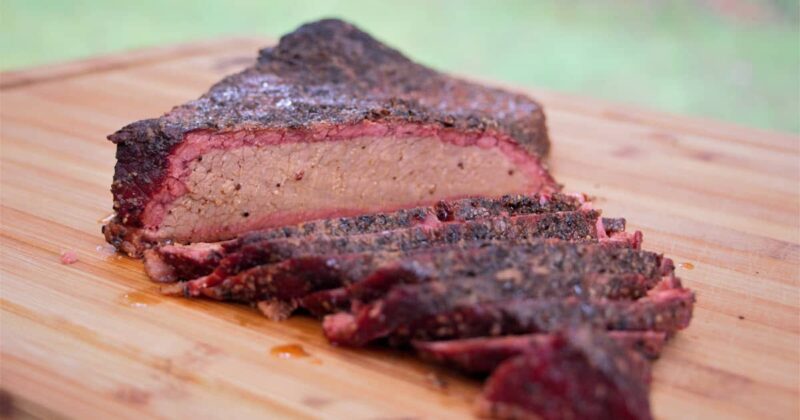
Understanding the transformation that brisket undergoes during cooking is crucial to grasping the essentials of portioning for any event. It’s well-acknowledged within catering circles that brisket dramatically reduces in size due to moisture loss and fat rendering. When it’s time to break down the numbers for your guests, one must account for nearly double the brisket serving size when purchasing raw, to meet the anticipated brisket quantity per person after cooking.
Let’s dive into a detailed exploration, walking you through the process that brisket experiences as it transitions from the raw state in the kitchen to a perfectly cooked delight on guest plates. This insightful behind-the-scenes look into brisket preparation will ensure you capture both the essence of satisfactory serving sizes and the reality of cooking shrinkage.
| Initial Raw Weight | Expected Cooked Weight | Brisket Quantity Per Person |
|---|---|---|
| 5 lbs | 2.5 lbs | 5 servings |
| 10 lbs | 5 lbs | 10 servings |
| 20 lbs | 10 lbs | 20 servings |
| 30 lbs | 15 lbs | 30 servings |
To give you a practical gauge, I recommend anticipating up to 50% loss of the brisket’s raw weight due to the cooking process—yes, half the starting weight can evaporate and render away in pursuit of rich flavors and tender textures. Therefore, if you’re aiming for that perfect 1/2 lb brisket serving size on each guest’s plate, you’re indeed looking at 1 lb per person in raw meat calculations.
While this might seem excessive when you first place your order with the butcher or supplier, my experiences—and plenty of them in bustling kitchens—assure you that this level of caution is warranted. Especially when you account for the further reduction from trimming the brisket before it even hits the heat. This rigorous approach to brisket serving size ensures that your guests leave content and your event is remembered for its ample, yet meticulously planned, spread.
- For light-eating adults or children, cut the 1 lb raw serving down to 1/2 lb, equating to a 1/4 lb cooked serving.
- For those with larger appetites, amp up the portions appropriately—often, the 1.5 lbs of raw brisket will yield a satisfying 3/4 lb of cooked meat.
In sum, the golden rule of thumb is to double the intended cooked weight when ordering your brisket, safeguarding against weight loss during the cooking ordeal. Keep this framework in mind, and the brisket quantity per person for your event will be right on target, evoking smiles and contented sighs from a satiated crowd.
Step-by-Step Guide to Using the Brisket Portion Calculator
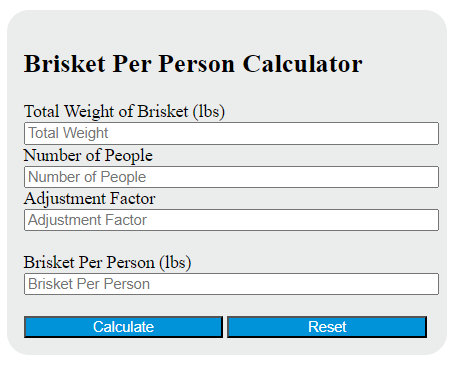
For many event planners, estimating the right amount of brisket for an event can be challenging. With the intent to simplify this process, I present a straightforward method to accurately calculate your needs using a brisket portion calculator. This invaluable tool takes into consideration the Brisket portion sizes and adjusts for the nuances of Brisket quantity per person, ensuring your planning for brisket is as efficient as it can be.
Let me walk you through the stages of using the brisket calculator to determine the perfect quantity required for your next event.
Inputting Your Event Details
The first step involves the crucial act of inputting specifics about your forthcoming event into the brisket quantity calculator. This involves stating the total count of attendees, and segregating them into adults and children, if necessary. By furnishing these details, you lay the groundwork for flawless event planning for brisket, setting the stage for a precise estimation of the meat requirement.
Calculating Brisket Amounts with Varied Portion Sizes
Following the gathering of event details comes the pivotal stage where we decide on the Brisket portion sizes. This is the critical juncture where we factor in individual appetites, other menu items, and, of course, the expected shrinkage from cooking and trimming. Here, our brisket quantity per person calculator stands as your ally, furnishing you with custom calculations that resonate with your event’s unique dynamics.
Let’s look at some visual data, charted for your convenience, showing different portion sizes and the corresponding uncooked brisket amount you would need:
| Portion Size Per Person | Total Adults | Total Children | Uncooked Brisket Needed (lbs.) |
|---|---|---|---|
| 1/4 lbs. | 20 | 10 | 10 lbs. |
| 1/2 lbs. | 20 | 10 | 20 lbs. |
| 3/4 lbs. | 20 | 10 | 30 lbs. |
As demonstrated in the table, you observe how varying the portion size impacts the amount of raw brisket that you need to start with. This visualization is handy when contemplating the brisket quantity per person calculator for your event, balancing between making each plate gratifying and keeping the costs under control.
Using the brisket quantity calculator is a breeze, meant to streamline your event planning for brisket. It allows you to tailor your meat order to the specifics of your event – no more, no less, just the right amount that ensures every guest relishes their share without an ounce of brisket going to waste.
- For modest eaters or events with multiple meat options, calculate using the lower end (1/4 lbs. servings).
- If brisket is the centerpiece, use 1/2 lbs. servings as standard estimates for adults.
- In case you know the crowd has larger appetites, planning with 3/4 lbs. servings will secure a plentiful meal.
Remember, these calculations should serve as a guide—a starting point to ensure your brisket catering hits the mark. The brisket quantity calculator is the culmination of experience and technology, crafted to ensure that your brisket event planning is both stress-free and precise. Choose wisely, and your event will be remembered fondly, one brisket slice at a time.
How to Adjust Brisket Quantities for Different Appetites
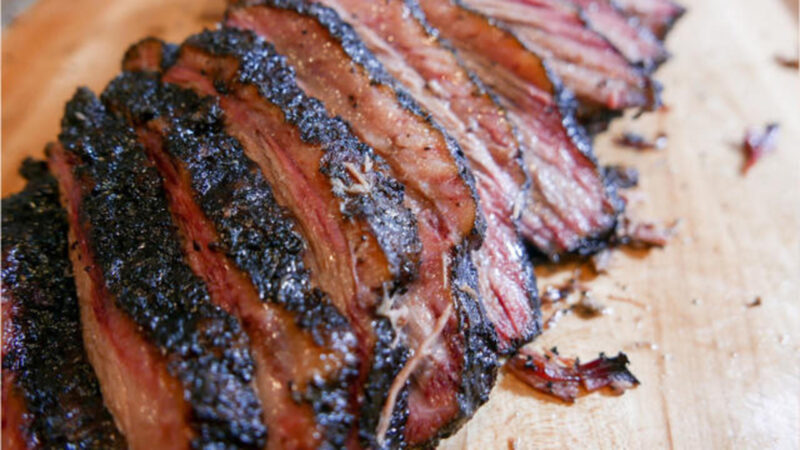
When preparing brisket for large events, catering to the varied palates and appetites of your guests is of paramount importance. My expertise in organizing large-scale culinary endeavors has taught me that brisket serving sizes are not a ‘one-size-fits-all’ affair. A comprehensive understanding of your guests’ dietary habits is crucial and it entails customizing brisket quantities to match everyone’s preferences, from the light snackers to the hearty meat lovers.
To navigate this aspect of event planning, consider these brisket serving recommendations:
- Boost portions for known heavy eaters to ensure their satisfaction.
- Trim portions for those who prefer lighter meals, optimizing the spread of sides and main dishes.
- Allocate smaller, child-friendly sizes for younger guests.
Additional adjustments need to be made when accommodating dietary restrictions or preferences. Eating is a very personal experience, and as we plan for quantities of brisket, we must do so thoughtfully. Here, I will provide a closer look at how these adjustments come into play.
Adjusting Brisket Portions for Hearty Appetites:
For those guests who see brisket as the highlight of the meal, nothing is more satisfying than a generous serving of this tender, smoked delicacy. Take the time to know your audience and, if in doubt, err on the side of generosity, especially for events known to host hearty appetites.
Scaling Back for Lighter Eaters:
Not everyone will want a large portion of brisket, especially if there’s a diverse spread of other dishes. For those eating lighter, your calculations can be adjusted down. This not only avoids waste but also respects the guest’s eating preferences.
Portioning Brisket for Children:
Children typically consume less than adults at events. Offering smaller brisket portions for the younger crowd is not only cost-effective; it also means they can enjoy a wider variety of foods without overwhelming their plates or wasting food.
The following table provides a quick reference for adjusting brisket servings according to the needs of different guests:
| Guest Type | Recommended Brisket Serving Size | Quantity of Uncooked Brisket Per Person (lbs.) |
|---|---|---|
| Adult Heavy Eaters | 3/4 lbs. | 1.5 |
| Adult Average Eaters | 1/2 lbs. | 1 |
| Adult Light Eaters | 1/4 lbs. | 0.5 |
| Children | 1/4 lbs. | 0.5 |
By tailoring portions according to the categories stated above, no guest leaves disappointed, and you, as the host, can rest assured that your brisket serving was up to par with guest expectations. Employing these strategies within the sphere of brisket serving recommendations ensures an expertly balanced banquet that can adapt to the rhythmic ebb and flow of your event’s gastronomic needs.
The Effect of Side Dishes on Brisket Serving Sizes
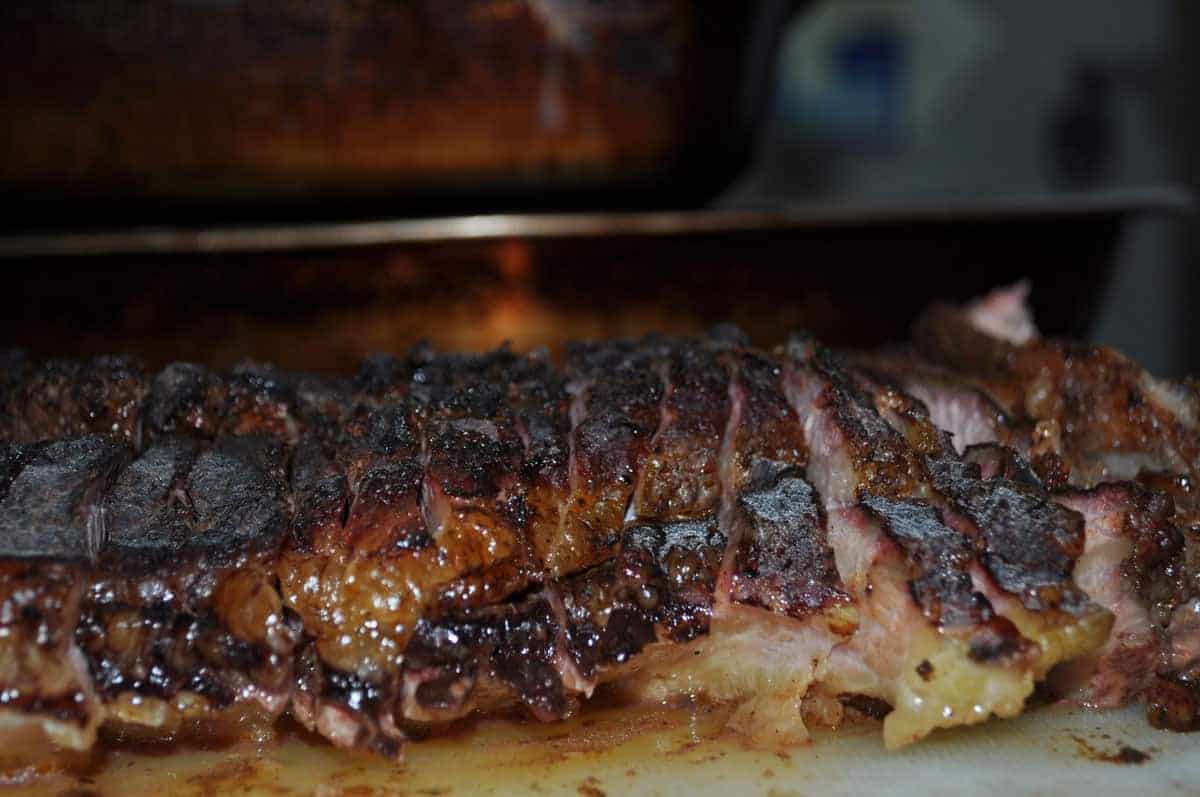
When it comes to brisket menu planning, one cannot emphasize enough the impact that side dishes have on the overall culinary experience. The selection of side dishes not only complements the main attraction—succulent, smoky brisket—but also significantly influences the quantity of brisket your guests will consume. Careful consideration of the weightiness and filling nature of these accompaniments ensures that the brisket and side dishes work in harmony, yielding a balanced meal where every component is enjoyed to its fullest.
In my line of work, specializing in creating unforgettable culinary experiences, I’ve seen firsthand how the composition of side dishes can pivot the portion sizes needed per person. It is not simply about the flavor profiles but also about the satiety levels these sides provide. Let’s delve into the art of Planning Your Menu Around Brisket with an informed approach to side dish selection.
Planning Your Menu Around Brisket
Heavier side dishes, such as loaded mashed potatoes and macaroni and cheese, are crowd favorites that add a comforting richness to the plate. However, they also mean that guests are likely to take smaller portions of brisket, thus adjusting the brisket serving size needed. On the other end of the spectrum, lighter sides, like a fresh cucumber salad or grilled asparagus, keep the focus on the brisket, potentially increasing the meat portions guests will indulge in.
- Ideally, a well-rounded menu boasts a balance between heavier and lighter sides, allowing guests to personalize their plates based on their dietary preferences.
- If brisket is the event’s main focus, consider offering a larger selection of light, refreshing sides to ensure the brisket remains front and center.
- For events featuring a wide variety of proteins and main dishes, incorporating heartier sides can help manage the overall food budget by reducing brisket portions slightly.
The table below outlines the relationship between side dish choices and the adjustments in brisket portioning. This critical information serves as the cornerstone in planning a menu that reflects consideration for varied appetites and occasions:
| Side Dish Type | Impact on Brisket Portion | Examples |
|---|---|---|
| Heavier Sides | Decrease brisket portion | Macaroni and Cheese, Scalloped Potatoes |
| Lighter Sides | Increase brisket portion | Garden Salad, Steamed Vegetables |
| Balanced Approach | Moderate brisket portion | Combination of Light and Heavier Options |
The careful selection and pairing of brisket and side dishes is integral to any successful brisket menu planning strategy. By forecasting the synergy between your brisket and its accompaniments, you can create a meal that is both satisfying and resourceful, ensuring no guest is left wanting and no expenses are squandered on surplus meats. Your aim is to cater to the collective palate with a spread that celebrates brisket and harmonizes with a variety of likable side dishes.
As an experienced caterer, I always keep in close touch with my clients to understand their vision for the event, which directly informs the brisket quantity and side dish pairings. It’s not just about the meat itself but how it plays with the textures, flavors, and fullness of the sides. Developing a brisket menu that is attuned to these dynamics translates into an optimized and appreciated meal wherein every bite accounts for a considered blend of taste and satisfaction.
“An expertly curated menu recognizes that the sum is greater than its parts – that the confluence of brisket and its sidekick dishes amounts to a dining experience that is thoughtfully layered and wholesomely indulgent.”
Tips for Buying Brisket: Quality vs. Quantity
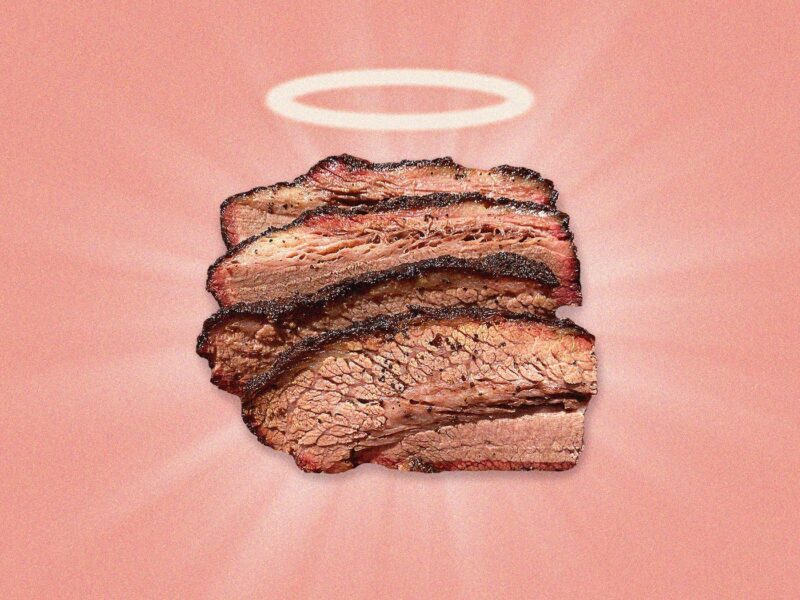
As an expert in culinary events, I’m often asked to buy brisket tips. One critical dilemma I encounter is the brisket quality vs quantity debate. Balancing these factors is essential for event success—quality impacts the overall flavor and guest satisfaction, while quantity ensures everyone leaves your gathering well-fed. Let’s explore the intricacies of selecting the best brisket for your needs without breaking the bank.
Considering the variety of brisket grades available, from Select to Prime, and including Wagyu, there’s a spectrum to choose from based on what you’re willing to invest for taste and tenderness. Interestingly, less-expensive cuts can still yield mouthwatering results when cooked properly. Nevertheless, for those special occasions, splurging on a higher quality cut like Wagyu brisket guarantees a memorable meal. Here are crucial points to weigh as you navigate this choice:
- Assess the event and know your guests’ expectations. Is the occasion a casual get-together or a high-end soirée that calls for the best of the best?
- Factor in your cooking method because certain cuts, especially the higher-quality ones, can shine with a specific cooking style, such as slow smoking.
- Stay true to your budget, but be creative and open to compromises that won’t sacrifice the experience. For instance, pair a slightly lower-grade brisket with bold flavors from your rub or sauce.
- For premium quality, consider reputable brands known for their outstanding brisket offerings, like Snake River Farms’ Wagyu brisket, which boasts superior marbling and flavor.
Here’s a table that provides a visual aid to discern between brisket grades and the pros and cons of each:
| Brisket Grade | Taste and Texture Characteristics | Cost Consideration | Best Cooking Method |
|---|---|---|---|
| Select | Least marbling, might require more seasoning | More budget-friendly | Slow-cooking to tenderize |
| Choice | Good marbling, a better flavor profile | Moderate price | Grilling or smoking |
| Prime | Excellent marbling, rich flavor | Higher price, more indulgent | Smoking for melt-in-mouth texture |
| Wagyu | Exceptional marbling, luxurious taste | Premium price, for special events | Smoking or grilling for an elite experience |
It’s not always about finding the priciest brisket; sometimes, it’s about knowing how to make the most of what you have. A well-prepared choice brisket can sometimes outshine a prime brisket that’s not handled correctly. Time and again, my experience shows that cooking skill often trumps material cost.
“Quality is more than a grade; it is the culmination of proper selection, handling, and cooking. Excellence in brisket requires a blend of quality cuts and the culinary prowess to present it in the best light.”
Applying these insights will enrich your brisket selection process, making the balance between quality and quantity less daunting. Wisdom in purchasing, matched to your event’s need for spectacle or comfort food, is the secret to a successful brisket experience.
Now, envisioning the perfect brisket for your event, consider the invaluable brisket-buying tips shared. Opting for quality or quantity does not have to be an either/or scenario—it’s more about the perfect marriage of both, based on the specific needs and nature of your event. When the moment comes to make that purchase, remember these guidelines, and your guests are sure to sing praises of the meal long after the last slice has been savored.
Expert Advice on Preparing Brisket for Large Groups
My passion for catering is driven by the delight of my guests enjoying a perfect meal, and preparing brisket for large groups plays a considerable role in this. Ensuring you have ample brisket to satisfy everyone, while also managing resources, becomes a delicate balance of Brisket catering guide principles and culinary finesse.
Dealing with Leftover Brisket
One concern that often plagues hosts is the possibility of brisket leftovers. While it’s vital to prepare enough to avoid anyone missing out, having leftover brisket can be a hidden boon. The trick lies in turning leftovers into an opportunity to extend the life of your spread into delicious subsequent meals.
Leftover brisket ideas include repurposing the smoky meat into sandwiches, stews, or even a hearty breakfast hash. This approach transforms what might be seen as excess into a culinary encore that guests can enjoy.
“Brisket’s versatility is its greatest strength—it can go from primal barbecue centerpiece to refined leftover delicacies without losing its soul-stirring allure.”
Take, for instance, “next-day” brisket tacos – a simple twist that infuses another cultural dimension to your meal. Here’s a snippet that showcases how you can easily incorporate your ample leftovers into a tasty encore:
| Leftover Dish | Role of Brisket | Tips |
|---|---|---|
| Brisket Sandwiches | Main Filling | Complement with coleslaw and barbecue sauce |
| Brisket Tacos | Protein centerpiece | Top with fresh salsa and a squeeze of lime |
| Brisket Hash | Hearty ingredient | Add potatoes and veggies for a complete breakfast |
Devising creative ways to use leftovers not only raises your reputation as a resourceful host but also demonstrates an appreciation for the food and effort that goes into preparing such a feast.
Brisket Cooking Timelines for Perfect Results
Brisket cooking timelines are fundamental to the success of your event’s main course. When you’re Brisket preparing for groups, plan for a significant investment of time—often between 12 and 20 hours—to achieve that tender, fall-apart texture that brisket is famed for. It isn’t just the cooking time that’s important, but also the rest time, allowing the juices to redistribute for maximum flavor and succulence.
- Begin with an early start to account for the slow and low cooking requirement.
- Ensure your timeline allows for the brisket to rest at least one hour before serving.
- Maintain consistent temperature control during cooking to achieve even results.
Here is a brisket timetable that you can refer to for just one brisket, remembering that cooking multiple briskets might require adjustments:
| Initial Cooking Stage | Time Needed | Temperature Range (°F) |
|---|---|---|
| Smoking | 12-15 hours | 225-250 |
| Resting | 1-2 hours | Room temperature |
It’s in the nuances of these timelines that the tender magic of brisket truly takes shape. Meticulous attention to the thermal journey of this cut ensures that your brisket becomes the star of the party, paying homage to both your know-how and the capacity of the brisket to stand as the linchpin of a gathering.
I’ve come to learn that patience is more than a virtue in brisket preparation; it is a requirement. It’s this unhurried approach that imbues brisket with its ineffable tenderness and delectable charm, ensuring that the time invested in cooking is time that rewards both chef and guest alike.
Brisket Serving Recommendations for Diverse Crowds
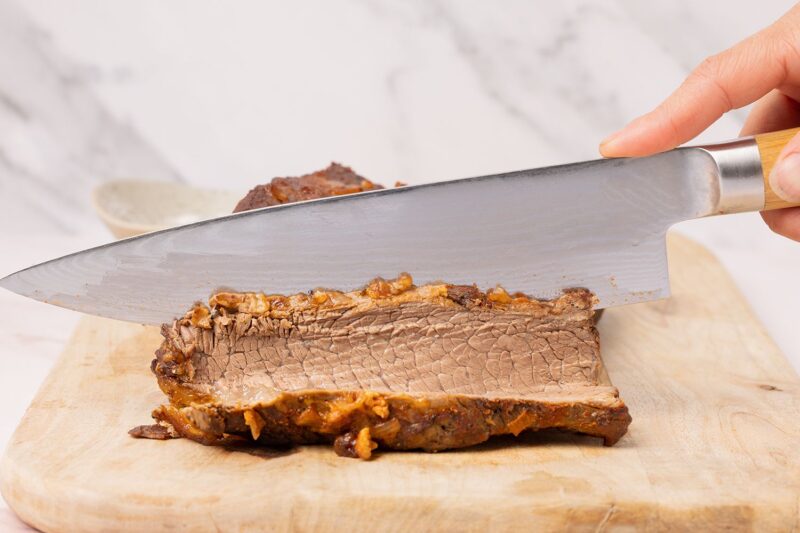
As I delve into the subtleties of catering, it has become apparent that an excellent brisket serving guide must include considerations for a diversely composed audience. Each gathering comes with its own demographic tapestry, woven together by varied age groups, eating habits, and dietary stipulations. Tailoring brisket portions to suit such diversity is not merely courteous; it is a cornerstone of conscientious hosting. Below, I offer a robust framework ensconcing the intricacies of brisket for diverse crowds, ensuring every attendee—from the burgeoning teenager to the diet-conscious adult—is contentedly provided for.
I suggest a dynamic approach to portion sizes inspired by my own experiences at numerous events that celebrated the savory delight of brisket. My approach is grounded in observing and understanding the demographics and dining preferences of the populations I’ve served. Brisket serving recommendations should be considered a malleable guideline, adapted to the unique dimensions of each group.
“In the context of feeding a multitude, aptitude in portion control is as invaluable as the seasoning on the meat itself.”
Let’s proceed to look at nuanced serving suggestions tailored for different segments of a diverse crowd:
- For teenagers and adults with hearty appetites, I generally recommend a slightly larger portion size to satisfy their robust hunger.
- When it comes to older guests or those with dietary restrictions, smaller portions paired with a variety of sides offer a fulfilling, yet controlled dining experience.
- To bridge the gaps, I strive for a versatile brisket station capable of serving up adjustable slices, thus empowering guests to dictate their portion size within reason.
Here is some quantifiable guidance that crystallizes my serving recommendations:
| Demographic Group | Typical Brisket Serving Size | Uncooked Brisket Needed per Person (lbs.) |
|---|---|---|
| Adults (Hearty Appetite) | 3/4 lbs. | 1.5 |
| Adults (Moderate Appetite) | 1/2 lbs. | 1 |
| Adults (Light Appetite) | 1/4 lbs. | 0.5 |
| Children/Teens | 1/3 lbs. | 0.66 |
As evidenced by the table, one can observe that brisket serving sizes are adjusted according to the likely appetite and demographic designation of guests. My brisket for diverse crowds approach champions inclusivity in portioning, as each person’s plate is a reflection of their appetite and dietary needs.
This inclusive methodology underpins my commitment to exemplary service—where each guest not only relishes their meal but also feels their individuality was considered in the preparation of it. Thus, brisket serving guide is more than simple arithmetic; it’s a comprehensive ethos aimed at culinary harmony for all.
FAQ
How much brisket per person do I need?
The general recommendation is to allocate half a pound of cooked brisket per adult guest. However, it’s important to consider factors like the presence of other foods and the appetite of your guests when determining portion sizes.
What factors should I consider for brisket serving sizes?
You should consider the specific cut of brisket, the extent of trimming, the cooking method, the crowd’s preferences, and the presence of side dishes when deciding on brisket serving sizes.
Why is it essential to use a brisket calculator?
A brisket calculator simplifies the planning process and provides a more accurate estimation by taking into consideration variables such as the number of guests and the cooking and trimming losses of brisket.
How does the weight of brisket change from raw to cooked?
Brisket experiences about 40%-50% weight loss due to cooking. Therefore, you should purchase raw brisket at double the desired final serving size to account for this shrinkage.
How do I use the brisket portion calculator?
Input details of your event, including the number of guests and desired portion sizes, into the brisket portion calculator to determine the amount of raw brisket required for your event.
How should I adjust brisket quantities for different appetites?
Account for variations in guests’ appetites by adjusting portion sizes. Large eaters might require more than the standard half-pound serving, while children and lighter eaters will generally consume less.
How do side dishes affect the amount of brisket needed?
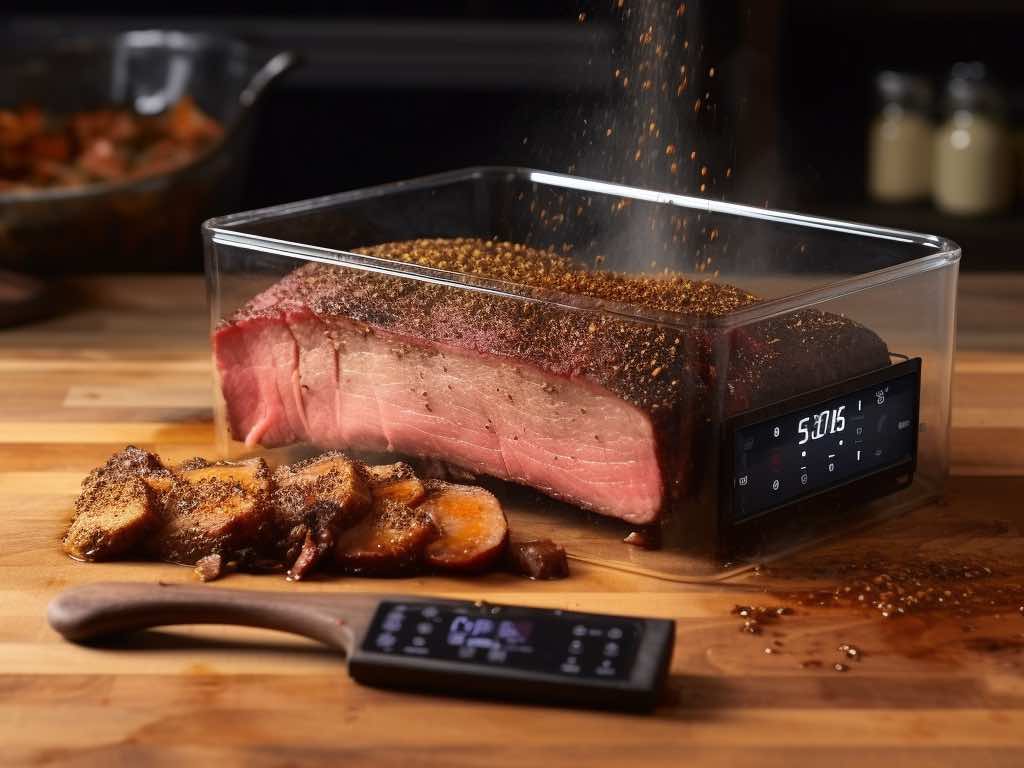
Heavier side dishes may reduce the amount of brisket consumed, whereas lighter sides might result in guests eating more brisket. It’s important to balance your menu accordingly.
What are the best practices for buying brisket, considering quality and quantity?
Focus on purchasing high-quality brisket that satisfies your guests’ taste preferences while ensuring you have sufficient quantity to feed the entire party without excess wastage.
What can I do with leftover brisket?
Leftover brisket can be repurposed into a variety of other dishes like brisket sandwiches, tacos, stews, or even brisket hash for breakfast.
How long does it take to cook brisket for large groups?
Brisket typically requires a cooking time of 12 to 20 hours, plus additional resting time before serving. Proper planning for these timelines is crucial for serving a perfectly cooked brisket.
How do I cater brisket servings to diverse crowds?
Consider the demographic makeup of your event, including age, eating habits, and dietary preferences, to adjust brisket servings so that everyone’s needs are met.
Conclusion: Essential Insights for Flawless Brisket Party Planning
As we wrap up our comprehensive exploration into brisket party planning, it’s evident that success lies in the precision of brisket serving-size guides and the use of reliable calculators. These tools and methodologies have been meticulously discussed to satiate your guests’ appetites without falling into the pitfalls of over-preparation or shortage. Whether serving a close-knit family gathering or a boisterous crowd, the principles laid down in this brisket serving size guide ensure that no guest leaves unsatisfied, nor does any morsel go to waste.
Enlightened by the insights shared throughout this brisket planning journey, you now hold the key to hosting events where the brisket’s rich flavors and tender textures take center stage, complemented by curated sides and thoughtful portioning. I’ve highlighted the importance of accounting for your crowd’s dietary variety, the nuances of cooking and trimming losses, and ultimately, how these factors harmonically dictate the brisket quantity per person required.
In every slice served and every plate garnished, the quintessence of brisket party planning is manifested through a harmonious balance of quality, quantity, and guest satisfaction. Remember, the brilliance of your event is measured not just by the abundance on the table, but by the meticulous planning that underpins it. Let each brisket event you craft be a testimony to the expertise and thoughtfulness you bring to the table, courtesy of the sagacious advice found in this brisket serving-size guide.

